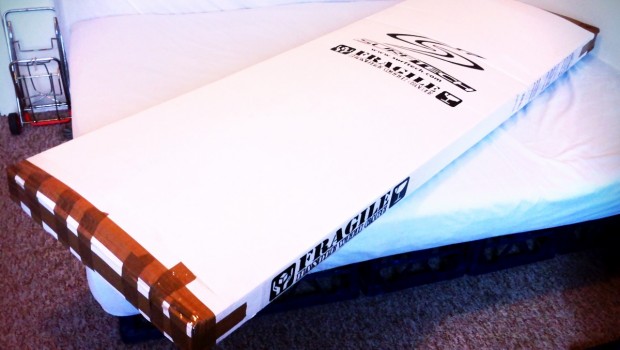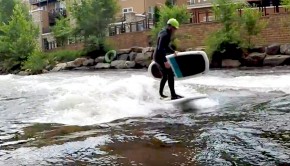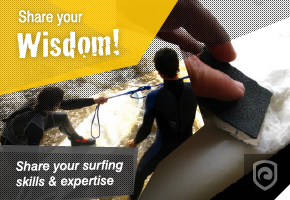How to Package and Ship a Surfboard
Even the boldest and most eye-catching fragile sticker won’t protect your board if it is not packaged properly for shipping. That’s why you want your board to be packaged bullet-proof and survive the grim journey through the many (tough) hands of the guys who pack the boxes on loading cars, airports, planes and trucks.
Have you ever prayed at the baggage claim for your surfboard to arrive at the airport in one piece? Finding your precious board smashed or cracked comes to no surprise for everyone who knows how airport stuff usually handles (oversize) luggage or sports equipment. The same worries are true for everyone who ships surfboards via post or private couriers (UPS, DHL, FedEx).
Treating and handling a surfboard is an extraordinarily delicate thing which only its owner understands best. Many river surfers are hesitant to lend their boards to friends let alone to a stranger. But once your board has left your hands for shipping, there is not much you can do.
If you do not want to leave the success of the shipment of your surfboard up to chance, you may find our surfboard packaging tutorial helpful. Here, we have put together a step-by-step guide how to properly pack your board.
Material
To package and protect your surfboard you will need a few simple things (paid links):
- a box that fits the size of your board
- filling material, e.g. bubble wrap, blanket, towels
- bumper, e.g. polystyrene
- duck tape / packing tape
- permanent marker
Get a box
First things first — get a proper box. This may sound like an easy thing, but cardboard boxes that fit a surfboard are rare. Ideally, you would use a box that has already been used to ship surfboards to surf shops. You’ll figure these boxes are hard to come by, but make sure to check at your local surf shop. If you’re not lucky, check with some local shapers who may have some (spare) blank boxes to give away — offering a six pack may prove helpful.
If you’re still not lucky, you’ll need to fabricate or cut your own cardboard box to fit the proportions of your board. When creating your own box, make sure you only cut one end of the box to keep one set of folding flaps. On the other end, cut out a new set of folding flaps that can be folded over. If you can’t manage to find a box big enough, get two bicycle boxes and put them together to make a single box that fits the size of your board.
Create a cushion layer (I)
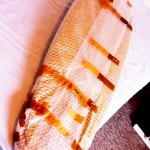 There are numerous things that can happen during shipping, so you really want to keep your surfboard protected. It’s absolutely crucial to make the best defense around the most vulnerable areas of your board. Use your imagination to figure which of the things you have at hand would make best as padding material. Note: Take out the fins and bubble wrap them separately. If your board has glassed in fins cut a piece of cardboard to cover them.
There are numerous things that can happen during shipping, so you really want to keep your surfboard protected. It’s absolutely crucial to make the best defense around the most vulnerable areas of your board. Use your imagination to figure which of the things you have at hand would make best as padding material. Note: Take out the fins and bubble wrap them separately. If your board has glassed in fins cut a piece of cardboard to cover them.
Here, I used a combination of different materials to create a thick and robust cushion layer in between the surfboard and the box. The first layer is created through the use of a thin board sock or a padded board bag (preferably). The sock wouldn’t actually protect the board from sharp bursts, but it does protect the board’s surface from scratches by adding a thin, extra skin.
Create a cushion layer (II)
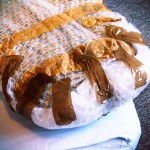 I used bubble wrap (#ad) to create a second layer. Simply wrap the bubble wrap around the board and use some duck tape to fix it. In surfboard shipping, the ideal way to create an air barrier is to use bubble wrap which is known for its well protection and little weight. Don’t be stingy with bubble wrap — the rails, nose and tail are the most vulnerable areas and deserve extra-padding if you have some spare. Also, make sure that the deck and bottom are well padded to withstand intrusion dents from other boxes or cases.
I used bubble wrap (#ad) to create a second layer. Simply wrap the bubble wrap around the board and use some duck tape to fix it. In surfboard shipping, the ideal way to create an air barrier is to use bubble wrap which is known for its well protection and little weight. Don’t be stingy with bubble wrap — the rails, nose and tail are the most vulnerable areas and deserve extra-padding if you have some spare. Also, make sure that the deck and bottom are well padded to withstand intrusion dents from other boxes or cases.
Create a cushion layer (III)
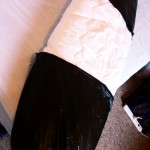
 This “quilt-layer” gives your board some extra padding but also extra weight — if adding these extra kilos won’t cause your shipping rate to skyrocket, do it.
This “quilt-layer” gives your board some extra padding but also extra weight — if adding these extra kilos won’t cause your shipping rate to skyrocket, do it.
Then, carefully place your board into the cardboard box.
Add extra padding, bumpers & stability
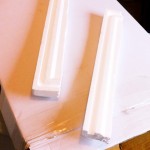 After taking care of the overall protection of your board, it’s time to move on to protect two very specific and fragile parts of your board: nose and tail. First, fill any open space and the sides with bubble wrap or towels to prevent the board from moving around in the box. Second, your surfboard package needs two “bumpers”. Cut out two small bars of polystyrene (styrofoam) and place one bar at the top of the box (nose) and one at the bottom (tail).
After taking care of the overall protection of your board, it’s time to move on to protect two very specific and fragile parts of your board: nose and tail. First, fill any open space and the sides with bubble wrap or towels to prevent the board from moving around in the box. Second, your surfboard package needs two “bumpers”. Cut out two small bars of polystyrene (styrofoam) and place one bar at the top of the box (nose) and one at the bottom (tail).
Polystyrene (#ad) is extraordinarily lightweight, robust and shock-resistant. It does not add much weight to your package, but lots of stability and further protects nose and tail from sharp bursts and deep drops (e.g. from conveyer bands onto baggage cars).
Seal the box
 Once your surfboard is padded and placed into the box, seal it with packing tape (#ad). Don’t be stingy on packing tape either — it’s important that the entire box is well sealed and that the padding stays in place during shipment.
Once your surfboard is padded and placed into the box, seal it with packing tape (#ad). Don’t be stingy on packing tape either — it’s important that the entire box is well sealed and that the padding stays in place during shipment.
True to the motto: tape the hell out of it!
Make sure it rides rail up
 Either print out a bunch of fragile stickers (#ad) and put them on the cardboard box or simply use a permanent marker (#ad) to write “Fragile” in big letters on the sides and add an “Up” pointing to the top of the box. Write “This Side Up” on the top of the box as large as possible (marking the box so that it rides rail up). Do not forget to put your name, address, e-mail and phone number in case it becomes lost!
Either print out a bunch of fragile stickers (#ad) and put them on the cardboard box or simply use a permanent marker (#ad) to write “Fragile” in big letters on the sides and add an “Up” pointing to the top of the box. Write “This Side Up” on the top of the box as large as possible (marking the box so that it rides rail up). Do not forget to put your name, address, e-mail and phone number in case it becomes lost!
To risk or not to risk?
Many river surfers are particular about the board they ride and that’s why they risk shipping their precious board abroad. If you are not too picky on the board you ride, it may turn out to be easier and cheaper to buy a used (or new) board at your destination. If you do care about the board you ride and want to take it to a remote place, efficient packaging is essential. The key to surfboard shipping is sufficient packaging and padding, a robust cardboard layer and proper labeling. And if you still worry about your board: get some insurance too.
Note: Riverbreak is reader-supported. When you buy through links on our site, we may earn an affiliate commission. Learn more.
-
http://www.approveme.me/ Charles B.Bedard
-
http://riverbreak.com/ Riverbreak Magazine
-

